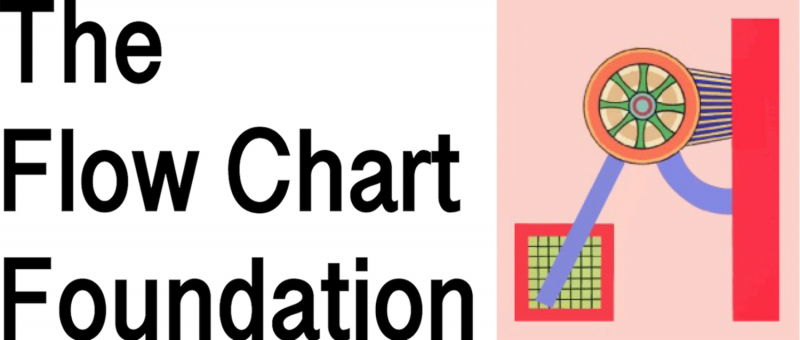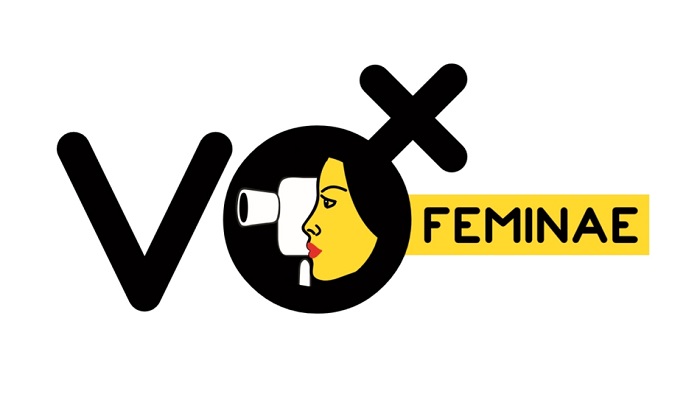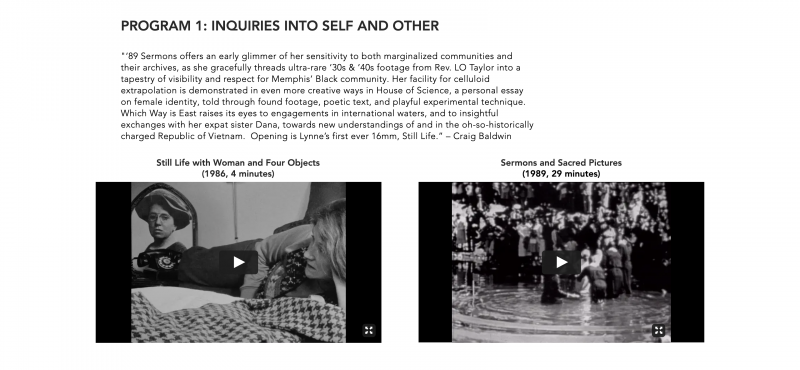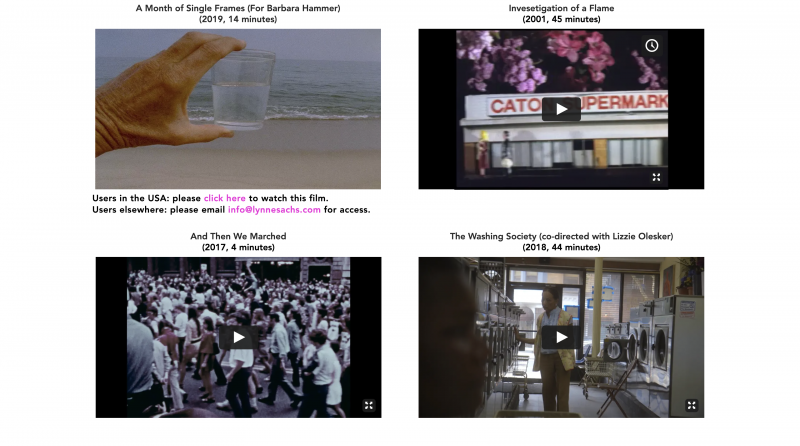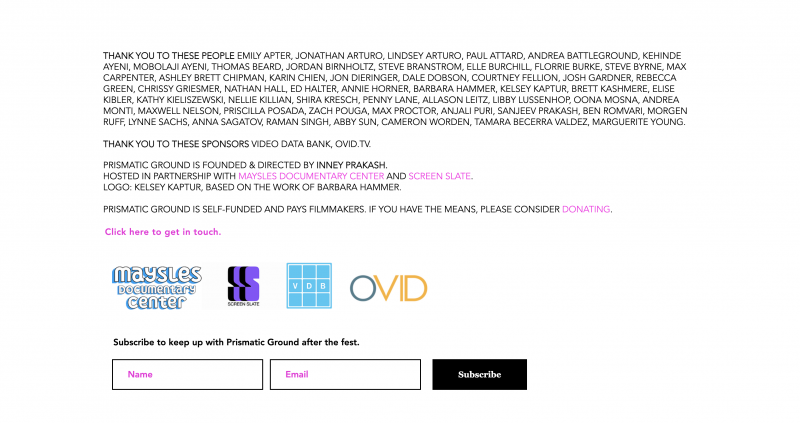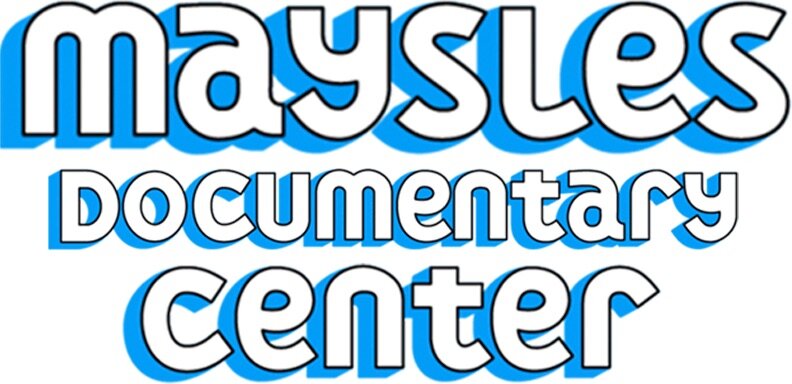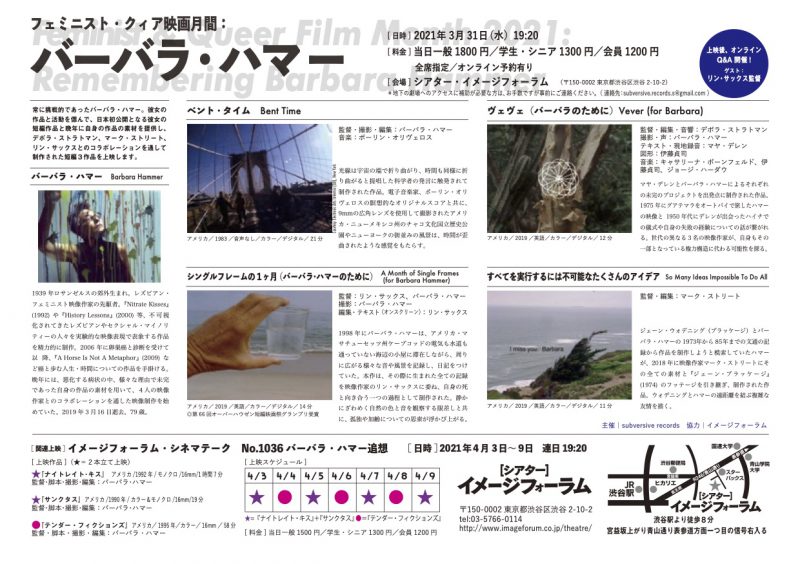
Jay Kuehner
April 2021
Festival Reports
Issue 98
http://www.sensesofcinema.com/2021/festival-reports/only-the-world-and-everything-in-it-the-2021-punto-de-vista-international-documentary-film-festival-of-navarra/
“I do not believe childhood is swathed in innocence” writes Lynne Sachs in her carta filmada to Jean Vigo, which traces the life of the child at play to his (yes, his) imminent revolt and the seemingly inevitable descent into violence. How did we get from Zéro de conduite (1933) to insurrection at the US capital, from petites diables to building the gallows?…we are increasingly living in a world where monstrous men who commit atrocious crimes can no longer be redeemed by the reminder that they too were once children.”
In its young history Punto de Vista (International Documentary Film Festival of Navarra) has staked out a distinguished identity, owing foremost to a progressive agenda and an experimental ethos. What might be designated vanguard elsewhere is de rigueur here (mapping an affinity, for example, with festivals in Yamagata and Ann Arbor as focal points in an alternate cinema landscape). With an emphasis on the personal over the prestigious, the program remains conspicuously reflexive: film as an engagement with the audience as much as the medium itself, leaning into its own sense of materiality.
I recall a conversation from the 2016 edition with a local (whose husband as it happened was a projectionist for the festival), in which she expressed incredulity that people were sitting through movies of such outlandish obscurity (the confounding film in question was Michael Snow’s La Région Centrale, 1971, a veritable axis of experimental cinema). “It’s like something you’d see at the Tate in London,” she reproached, offering an involuntary compliment to the festival itself. Conceiving of Baluarte – the festival’s starkly modern granite home – as akin to the Tate Modern is probably an instructive way of approaching the festival. You can still bring the kids (indeed Punto de Vista offers filmmaking workshops for youth), but keep in mind that the climate is one of careful curation. Those seeking the “heroic artists of the photochemical avant-garde” (as per a Robert Fenz tribute) may feel perfectly at home.
The 2021 edition felt especially intentional, on evidence alone but also in the context of the pandemic, in which, ever-hungry for cinema, we may have failed to notice that an online festival is a contradiction of sorts. Can one feast alone? Fortuitously, Punto de Vista’s calendar dates put it at the fringes of the virus timeline; narrowly evading the early dark days and, a year on, emerging upon latter light. Thus this year the festival was able to accommodate in-person attendance while also offering a remote platform, a consolation of sorts to those of us who couldn’t be privy to actual public screenings, or the more visceral iterations of the program – such as the light and sound explorations of Lois Patiño and Xabier Erkizia in the local planetarium.
Also site-specific was a listening session for The Works and Days: The Black Sections, a sound collage that emerged out of C.W. Winter and Anders Edström’s geographic epic of fourteen months in a mountain village in Kyoto Prefecture, Japan (The Works and Days (of Tayoko Shiojiri in the Shiotani Basin). The film itself justifiably earned the Grand Prize for Best Film, and is deserving of an entry all its own to do it justice.
Roaming the festival’s retrospectives (Holt, Vogel) one could feel the texture of time embedded in the grain of film stock, and the sensation bled (like light of course) into much of the contemporary Official Selection, where artists consciously employed celluloid for its expressive and political possibilities. This was no aesthetic coincidence, but rather a statement of intent, artistic director Garbiña Ortega effectively acting as chasseur des images in support of the festival’s boggling, and beguiling, tagline: Las cosas que no fueron también son.
What wasn’t but also is. What to make of this strange koan, metered out on the festival poster like a poem, imposed on an image of a landscape split by different focal points? The strange syntax alluded to cinema’s torque of time, both its evidential and spectral attributes, and to the enigmas of actuality and actualising. It also informed the theme of the festival’s continuation of correspondencias,1 in which several filmmakers were asked to make filmed letters addressed to auteurs whom they did not personally know and existed beyond their own cinematic orbit. The correspondences that once weren’t now also are.
But the idea for me found traction in the unsuspecting session dedicated to the collective work of the agency Forensic Architecture, whose methodologies involving spatial architecture and digital modeling are used to investigate cases of human rights violations (one example: the the killing of Harith Augustus). Researcher Nicholas Zembashi’s Zoom presentation was typically banal (as the format goes), but it keenly delineated the firm’s methodology that recruits both technology and philosophy in profound measure. The simple premise, that “there are still gaps in vision” even in, or on account of, our ever-digitised surveillance society, was not radical, but the notion that prevailing ideologies (call them power structures) often thrust us into such gaps was compelling. Locating this “site of inhibited vision, where our knowledge is often obfuscated,” is the intent of their forensic model, using data from existing audiovisual evidence (body and dash cams, CCTV, open source) to extrapolate a faithful rendition (often via 3D animation, VR, and digital mapping) of what is excluded from view. What wasn’t (seen) also is (made visible).
Forensic Architecture’s conception of an “indexical surreality” is certainly not without relevance to any current consideration of the filmic image (indeed Zembashi’s modest presentation brought to mind nothing less than Theo Anthony’s latest riff All Light Everywhere). It occurred to me that a more prosaic (or perhaps just less technologically refined) instance of investigative aesthetics was unfolding within the festival’s main slate, which tends not to discriminate against short and medium length endeavours. Although the modalities at work contrasted beyond distinction, there was a commonality among the analogue and hypermedia alike in their respective acts of imaginative reconstruction, and retelling. The previously unimaginable was given contours, illuminated, and subject to a new kind of accountability.
Miranda Pennell’s Strange Object considers how the mysterious ruins of a desert habitat are fitted into an archive, images of this once civilised but now isolated landscape smudged with the fingerprints of unknown historians. The brittle traces of imperialism have been removed from their source, imprinted on a page in an album, its legacy of barely perceptible dimensions revealing a damning point of view upon closer inspection. Such aerial images could only have originated from a plane, and such planes only from the command of bombardment. The historical view coincides with its own instance of destruction. The “strange objects” are undisclosed fortresses that were in fact Dervish settlements established by Mohammed Abdullah Hassan, leader of colonial resistance in the Anglo-Somali war. He is said to have mistaken his airborne assailants for angels only until his white robe was singed by flames (but perhaps such legend is spoken only in the patois of empire).
A propulsive montage of photographic stills constructs Jorge Moneo Quintana’s archival portrait of the Basque capital, Vitoria-Gasteiz. In Ictu Oculi (begiak hesteko artean) – “in the blink of an eye” – assembles a cumulative, seven-decade account of a city block through the ages, as the convent of St. Francis, a gothic marvel made of stone and founded by Assisi himself, is reduced to rubble and eventually makes way for…..a bank. The found footage (some of which originates from glass plates) comes to life by way of a rapid editing scheme, superimpositions, and an elastic sound design composed of field recordings and synthesised score. A city symphony that hardly strays from a fixed position but ranges instead through time, the film was especially resonant among locals, winning the audience award.
The inevitable slippage that occasions any attempt to describe a given work becomes a formal device in Riccardo Giacconi’s appositely titled Ekphrasis, in which a narrator guides the viewer through a slideshow of images from south Tyrolean territory during the time of the 1939 “Option Agreement” (Die Option or Südtiroler Umsiedlung, the option being Nazism in Austria or Fascism in Italy). Descriptions home in on seemingly innocuous features – hair, uniforms, social formations – to reveal darker details such as right-armed salutes, destruction, and pageantry of power. Voice and image do not consistently align, and the implied “you” of the viewer is situated in varying degrees of proximity to an unfolding narrative of increasingly ominous detail. Distant spectator becomes participant observer, ultimately subsumed by violence.
Cryptic and complicated like much of the Tyrolean conflict itself, the piece obliquely engages in contestations of Heimat and Vaterland, and concludes on an image that references the name of one embedded Alexander Langer, a writer and advocate of multi-ethnic co-existence. That his graffitied name is disparaged at the site of a railway station bombing in 1986 only further complicates any forensic inquiries in this film that began as a sound installation, its imagery previously only inferred.
Deep in a village in Chiapas a truck selling canisters of propane gas makes the rounds, blaring jingles to potential customers as it winds through the town’s dirt and cobblestone byways that plunge into the verdant landscape. There are mangos for sale by the roadside, and even the town’s antiquated central loudspeaker broadcasts the availability of local pork to the resident “gentle homemakers”. The sense of a patent ethnography, condensing several years of shooting into what feels like a day, is disrupted when a Zoque woman takes to the airways to advocate on behalf of a women’s indigenous group, intent on recovering land rights and historical memory in the long wake of the Chichonal volcanic eruption that devastated their village (seen covered in ash in the film’s opening newsreels from 1982).
Charles Fairbanks’ and Saúl Kak’s ( ( ( ( ( /*\ ) ) ) ) ) (Echoes of the Volcano) proceeds to take in the languid village tableaux in fixed shots and aural dispatches: a dog naps on the pavement, a pig escapes its pen, a paletero pushes his cart, a billfold is stolen, tortillas are for sale, mariachis for hire, and a preacher peddles forgiveness. A random encounter on the street finds soundman Kak (himself a Zoque speaker from nearby El Guayabal) demystifying his microphone to a group of kids who want to know if he’s “working with the gringo” (an offscreen Fairbanks). Where the film operated in a register of composed but playful deference, it now became host to these more candid interlocutors, boys whose families were displaced from nearby towns by the Chichanol eruption. “Our Grandmothers died there,” tells one, his face crowding the frame. A final long shot, of kids being kids as they retreat back into a life of anonymity, offers an impromptu but symbolic image of diasporic unity among the Zoque.
From the pain of displacement to the sorrow of exile: a diaristic portrait of a life lived clandestinely (in Tunisia, in spite of the Arab spring, homosexuality remains criminalised under old French colonial law) turns the everyday into the epic, and the intimate political. Mouaad el Salem’s This day won’t last feels necessarily both slack and urgent, disembodied and deeply inhabited. A white curtain flutters in a door frame, the fronds of a palm appear stubbornly inert, and a colony of ants scurries on terrazzo tile; all are images that betray a life lived in fear, in waiting, with the mostly unseen director considering for the first time “how to leave my country”. More personal snapshots – a package of cigarettes strapped to a bare torso, lipstick traces on a cropped face – may be tossed off but land potently (some images are not at liberty to remain meaningless). A double exile awaits in this inhalation of a film, as he who flees must also surrender his family. A Markerian cat tellingly appears throughout, providing comfort, bearing witness.
“Be good, if you can’t be good, be good at it”, and “cheer up you miserable mortal” read a few notable salutations from the letters received by a Scottish woman (the director’s mother) who emigrated to the US in the ‘70s in search of a better life. How do you create a cohesive memoir, she asks, filmed now by her daughter at home in Scotland. “It’s hard,” she confesses, holding a magnifying glass to an old photo album that seems to store her memory more faithfully than her own recollection. Liberty: An Ephemeral Statute (Rebecca Jane Arthur) thus becomes a displaced/delayed home movie filmed in part abroad, a generation removed, as a daughter searches in her mother’s footsteps, using her letters from friends and family as an epistolic framework through which a floating record of the present becomes personally anchored to the past. Images of New York, San Francisco and Honolulu (Irene Dunn made good on her wanderlust), all appear hopelessly vintage on account of the super 8 footage, and are contrasted with domestic scenes back in the kingdom of Fife, where rain gathers on the clotheslines and rosehips. The act of filmmaking invokes a parallel passage by the director who, by tracing the autonomous arc of her preceding mum, is shaping her own destiny as well. (Coincidentally, the film rhymed nicely with Glimpses from a Visit to Orkney in Summer, 1995, Ute Aurand’s silent Bolex ode to Margaret Tate, subject of a tribute at Punto de Vista 2015).
Simon Liu’s Signal 8 travels in the opposite direction, the view of an expat now gazing upon the city he left behind. Hong Kong lends itself to pop nostalgia, but Liu seeks out more marginal spaces, with only brief lyrical glimpses of the harbour’s old fishing boats buoyed in the purple light of dusk, or a fireworks display above the skyline scored to the Ronettes. Instead, the overflow of a fish market aquarium and the stray light travelling on an escalator evoke the eerie calm of the ordinary. A civic construction worker shown labouring over an open pit becomes an uneasy metaphor for the city’s precarious future. The sound design registers an intimate voice humming a melody (suggesting the insouciant presence of a wandering director), but is eclipsed by the discordant noise of the city itself, unable to pick up any clear reception. Not the most recent dispatch from Liu – Signal 8 was edited before the citywide protests over the extradition bill – but it nevertheless feels prescient in its anxiety.
The blanched and blindingly bright expanse of an industrial saltworks on the 28th parallel separating Baja north from south is the site of Santiago Bonilla’s mesmeric Paralelo 28. An abstract and otherworldly depiction of machine and matter on a grand scale, Bonilla’s portrait seeks out the human – and perhaps uniquely canine – presence within the saline science fiction. In the bowels of machines he captures portraits of welders at work and rest, illuminated by the blue light of flame or staring down the lens of the camera. Their hands are worn but steady. Over the radio waves can be heard crane and truck operators chatting idly, circulating a story of a one-eyed dog known to have poached the welders’ lunches. The tale functions as a kind of sound gag amid the literal and symbolic weight of such arduous labour, while its visuals haunt with their ghostly light. Is this the way a welder sees after the eye protection is removed, shards of light shimmering across the optic plane, or is it the view of a fabled one-eyed dog roaming the vast wasteland of the Exportadora de Sal in Guerrero Negro?
Elsewhere in Mexico’s interior a chorus of voices is culled together in a sonic nocturne, telling of the strange menace and spiritual succor of the desert’s night sky in Felix Blume’s Luces del desierto (Desert Lights). Unidentified voices tell of a sky radiant with colour or pierced with fireballs, host to stars that appear to walk or compete with gadgets, full of apparitions or the vestigial trails of migrants. Both eye and ear become attuned to the desert’s expanse of night sky. The sound of cowbells, whinny of horses, and howl of wild desert animals grounds the floating perspective but resists orientation. Tales emerge from the depths, conjuring a supernatural spell: of a ritual pyre through which believers leap, a rabbit transformed into an owl and then a cactus, a bloodsucking she-spirit who takes children, and a beautiful young woman who suddenly becomes old. Other lights reveal less mystery: men hunting rabbits by truck, lamp and rifle; a guard inspecting the cars of a passing train; a wedding on a basketball court beneath a play of fireworks. Oneiric, haunting, soporific, this enigmatic tale is an unclassifiable piece that bodes well for sound artist Blume’s foray into visual media.
A seance of a quite different nature attends Pablo Alvarez-Mesa’s Bicentenario, in which the anniversary of Simón Bolívar falls under a far more circumspect gaze than its honorary ceremonies and monuments would avow. The film begins with found footage of the 1985 Palace of Justice siege in Bogotá, as rather striking images of military armour breaching the Supreme Court unfold while a civilian (in tuxedo) proceeds to feed the pigeons in the adjoining Bolívar Square. But any semblance to an historical documentary ends there, and a more impressionistic project ensues: voices can be heard whispering in convocation of El Libertador, and the camera (Bolex) begins its tour of the the liberator’s path, commencing upon what is now a verdant pasture of grazing cows.
Alvarez Mesa’s visual schema suggests that over the graves of ancestors not only will grass grow but drones too will fly, and where the birth of a nation began young girls today are idly rollerblading on its pavements. Less ironic than ambivalent, however, the film’s itinerary reveals a liberation mythos that has, over time, become obscured and ineffectual by nostalgia to the ravages that have plagued the country in the intervening years. An appetite for despotism is part of such a legacy of liberation, and a war-to-the-death mentality continues to inform cartel and political violence. But the celebrations must go on, with school children dressing the part and reenacting battle scenes while enlisted battalion soldiers are obliged to conduct performative displays of loyalty and historicity.
“Flicker the candle, Bolívar” implores the hushed voice of the clairvoyant, channeling the presence of the patrón of this modern country (but failed Gran Colombia super-state). “There is grief” she continues, “and sorrow. The violence runs very deep.” In this interminable wait for a sign from its liberator, in the wish to find continuity with the past, it is precisely the unspoken pain dredged by the medium that Bicentenario gives voice to. It is the voice of mourning – given tone and texture in the patina of 16mm – drowned out by the noise of so many parades.
Award winners proved dynamic in their very simplicity. While the computer generated images of fans swaying at Hillsborough stadium in Nicolas Gourault’s This Means More keenly brought to mind the work of Forensic Architecture (albeit of lesser consequence), such simulation was a far cry from the starkly analogue means employed by Morgan Quaintance to evoke a south London of his youth in Surviving You, Always, which was awarded the Jean Vigo prize for Best Director. Punk and melancholic, this effecting love letter also feels like a rejoinder to the temptations of nostalgia. A retrospective glance at a year of psychedelic weekends finds the director, via wistful on-screen text, lamenting the loss of lucidity incurred by the promise of drug-induced insight. Cue the wizened voice of Timothy Leary over coarse black and white portraits of ‘80s house parties, and the uncertain virtues of cellular wisdom become increasingly ill-attuned to the realities facing a black middle schooler in a constant state of exile, who avoids his housing estate and school to evade escalating conflicts. “Becoming nobody” in a spiritual sense was not particularly sound advice for someone already risking personal and social alienation.
All the functions of consciousness are the work of a chemical process, intones Leary, as Quaintance meanwhile relays in few words the promising but sad history of a failed relationship. So, too, is film the work of a chemical process, his images seem to reply in defense, likewise employed toward the raising of consciousness. This is the film’s stinging irony, sharpened by its contrapuntal narratives driven in oppositional tension. Memory is slurred like the frames that stutter and halt, only to be resurrected with utter clarity in the hindsight of desire. The silence of the written narration produces an uncanny intimacy, as if this might be the first instance of a long-held privacy or inner monologue finally released into the world. It also begs status as poetry: “You stood in the doorway to stop the dogs getting out. I was running to avoid the rain.” Quaintance’s film reminds us that, forever seeking to step outside ourselves, we may have lost sight of the simplest steps back in.
Perhaps the less said, and more seen, of Jayne Parker’s Amaryllis – a study (awarded Best Short) the better. And that might be the point, except that this film appears to transcend any nominal intent, rather organically engaging perception to an exquisite extent; such are the saturations of color and play of texture within the fact of a singular red flower. The miracle of the blossom – behold supple pistil, witness delicate anther and filament of stamen – coincides with its miraculous rendering on film, both acts of photosynthesis, a metabolism of light. The ephemeral film could function as a visual distillation of Elaine Scarry’s essay “Imagining Flowers”, in which “the daydreamed blossom….expresses the capacity of the imagination to perform its mimesis so successfully that one can not be sure that an act of perception has not actually taken place.”2
Writer and curator Alexander Horwath (former director of the Austrian Film Museum) once rather pointedly responded to a BFI documentary poll not with “ten isolated, shrink-wrapped canonical works” but a seminar instead, “a format closer to what I think is at the heart of the ‘documenting impulse’ – putting one thing in relation to another thing, and then to another thing… One of those things is always ‘the machine’, the film medium and its specific capacities. The second of those things is always ‘the world’, ‘actual life’ – whatever we mean by it.”
Films in dialogue with each other is, of course, what comes to define a festival’s character, ideally more interrogative than didactic in conception. In the case of Amos In Wonderland, the dizzying tribute to cinema legend Amos Vogel by compatriots Horwath and Regina Schlagnitweit, the question was: how do you curate a curator? No point in mimicking Vogel’s own programs, they concede, instead mapping Vogel’s curiosities into both a chronological reflection of his emigré experience and as an encounter with the historical forces of the ongoing moment. As with German cultural theorist Aby Warburg’s attempt, by means of the creation of an atlas, to trace a certain afterlife of cultural affect, so too did Vogel and now Horwath and Schlagnitweit seek “to allow its spectators to experience for themselves the “polarities” that riddle culture and thought.”
The idea of film as a subversive art might thus be seen as a project in perpetuity, not necessarily transgressive in the context of its immediate milieu, but in the unforeseen dissonance and resonance it might induce in relation to future trauma and pleasure. To wit, how does one watch Nicolás Peredas’ epistolic quotidian-inspired ode in his letter to Chantal Akerman – in which he proposes to rent his sister’s Coyoacan flat to the Belgian director – in light of the inclusion of Saute ma ville (1975) in the Vogel program? (Querido Nico, are you mad? Have you not seen the condition of her kitchen?!). The loss of Akerman only becomes more devastating by the doubling of such proximities.
The dialogue expanded, refracted, mutated; leaving one to consider, for example, if in Tunisia one is free to watch Keneth Anger films? Could one speculate a link between Anger’s seminal Fireworks (1947) and Mouaad el Salem’s This day won’t last, both portraits of desire under radically different conditions of suppression (and both filmed at home out of sight from their families)? Production credits from Brussels suggested that El Salem succeeded in leaving his native Tunis which, in the parallel cinematic universe offered up in the Vogel program, also acted as a site of refuge sixty years earlier for young Algerians displaced by the war in J’ai huit ans (Olga Poliakoff, Jann Le Mason, 1961). A film of profound and heartbreaking economy born under the actual aegis of Franz Fanon, its montage of children’s war-torn drawings offers an unsettling, and unprecedented, view of colonial violence. The title condemns both a war too long and a childhood cut short.
So it was that the viewer moved through the various states of Amos: from a program devoted to ‘Secrets and Revelations’ (title of a chapter from Vogel’s tome) to one of ‘Children Have Their Own Laws’ (taken from Franz Cižek, painter and father of the Child Art Movement in Vienna). “I do not believe childhood is swathed in innocence” writes Lynne Sachs in her carta filmada to Jean Vigo, which traces the life of the child at play to his (yes, his) imminent revolt and the seemingly inevitable descent into violence. How did we get from Zéro de conduite (1933) to insurrection at the US capital, from petites diables to building the gallows? Perhaps a riposte could be located in the Vogel-inspired Rentrée des classes (Jacques Rozier, 1956), in which a snake loosed in a schoolroom by a mischievous boy is ultimately returned to its river source, having frightened all but harmed none. The boy is seen pausing for moments of reverie in the water under a midday sun, simply floating. Pedagogy, with its vested interest in codes of conduct, might acknowledge that instances of revelation can prove more instructive than rules. But then again, we are increasingly living in a world where monstrous men who commit atrocious crimes can no longer be redeemed by the reminder that they too were once children (see also: Raya Martin to Wes Craven).
Horwath’s proposed “lessons” in documentary, like Vogel’s before him, were considered fertile for those willing to take the time “to return from our fictitious paradise of ‘nonfiction’.” Such ‘time’, at its essence, takes looking as infinitely variable, informing the movement from what wasn’t to also is. Deborah Stratman, in her contemplative missive to Nancy Holt situated in and around the Great Salt Lake, intimates the power but also the limits of cinema in the face of history. Her salutation – “For the time being…In the interim…In the course of time…From day to day” implicitly asks: What more can cinema be than a monument to the provisional? And wasn’t that also the point of all the sublime toiling Holt and Smithson did out in the desert?
Or was cinema, to borrow the phrase ironically invoked by Nicolás Pereda, just a means of putting a uniform on an eye that was otherwise naked? It was reassuring at least to think that Punto de Vista, much like the deserved description of Vogel in the program, was fearless, and was wise about the ambiguous constellations of power, enlightenment, and pain. On second thought, the festival was less like the Tate Modern and more akin to stepping into the home office of Vogel, papered over by a history of pictures, all of them resonant by virtue of being beyond our imagination, either on account of impossible beauty or unimaginable cruelty. The seventh art could still teach us how to be more at ease in our discomfort, and find agency in counter-perspective.
Punto de Vista International Documentary Film Festival of Navarra
15-19 March 2021
Festival website: https://www.puntodevistafestival.com/
Endnotes

